- News
- Reviews
- Bikes
- Accessories
- Accessories - misc
- Computer mounts
- Bags
- Bar ends
- Bike bags & cases
- Bottle cages
- Bottles
- Cameras
- Car racks
- Child seats
- Computers
- Glasses
- GPS units
- Helmets
- Lights - front
- Lights - rear
- Lights - sets
- Locks
- Mirrors
- Mudguards
- Racks
- Pumps & CO2 inflators
- Puncture kits
- Reflectives
- Smart watches
- Stands and racks
- Trailers
- Clothing
- Components
- Bar tape & grips
- Bottom brackets
- Brake & gear cables
- Brake & STI levers
- Brake pads & spares
- Brakes
- Cassettes & freewheels
- Chains
- Chainsets & chainrings
- Derailleurs - front
- Derailleurs - rear
- Forks
- Gear levers & shifters
- Groupsets
- Handlebars & extensions
- Headsets
- Hubs
- Inner tubes
- Pedals
- Quick releases & skewers
- Saddles
- Seatposts
- Stems
- Wheels
- Tyres
- Health, fitness and nutrition
- Tools and workshop
- Miscellaneous
- Cross country mountain bikes
- Tubeless valves
- Buyers Guides
- Features
- Forum
- Recommends
- Podcast
review
£3,350.00
VERDICT:
A responsive aero road bike in a race geometry – now with the all-weather stopping abilities of hydraulic disc brakes
Weight:
8,500g
Contact:
At road.cc every product is thoroughly tested for as long as it takes to get a proper insight into how well it works. Our reviewers are experienced cyclists that we trust to be objective. While we strive to ensure that opinions expressed are backed up by facts, reviews are by their nature an informed opinion, not a definitive verdict. We don't intentionally try to break anything (except locks) but we do try to look for weak points in any design. The overall score is not just an average of the other scores: it reflects both a product's function and value – with value determined by how a product compares with items of similar spec, quality, and price.
What the road.cc scores meanGood scores are more common than bad, because fortunately good products are more common than bad.
- Exceptional
- Excellent
- Very Good
- Good
- Quite good
- Average
- Not so good
- Poor
- Bad
- Appalling
The new Bianchi Aria Disc is an aero road bike that offers efficiency, sharp handling and a responsive character, now with the additional all-weather assurance of disc brakes – in this case from Campagnolo. At £3,350, it's a sizeable investment.
- Pros: Responsive, impressive performance from hydraulic disc brakes
- Cons: You can get similarly specced bikes at lower prices
When I reviewed the rim brake version of the Bianchi Aria last year I described it as 'a fast-reacting aero road bike in a race geometry for those with a need for speed'. The Bianchi Aria Disc is similar... but with disc brakes.
> Find your nearest dealer here
I'm not being flippant in saying that. Even putting braking to one side, some disc brake bikes are a little different from their rim brake alternatives. It's not just a question of the designers removing the rim brake mounts, slinging on some disc brake mounts, and Bob's your uncle. The frame and fork have to be re-engineered for discs and occasionally something is lost in the translation. The Aria Disc, though, retains all the good bits from the original.
As well as a month riding the Aria Disc at home, I took it out to Mallorca for a week (I'm not bragging, I'm just telling you!) where I did a few longer rides, including up and down Sa Calobra (Coll dels Reis, if you want to be correct about it) a couple of times, so I reckon I have a firm handle on its capabilities, and this is a bike I like a lot.
The Aria Disc responds keenly to increased effort. Our 59cm model, built up with a Campagnolo Potenza groupset, isn't especially light, hitting the road.cc Scales of Truth at 8.5kg (18.7lb), but it feels direct when you put in the power, a meaty bottom bracket helping to keep everything solidly in place.
The deep-section head tube does a similar job up front. Like most performance-focused bikes these days, the Aria Disc comes with a tapered head tube/fork steerer – the upper bearing is 1 1/8in, the lower is 1 1/4in – and there's no lack of steering stiffness here. The bike felt great whipping through hairpins, giving enough confidence to attack them at speed rather than backing off to allow for imprecision.
The Aria Disc feels as manoeuvrable as the rim brake version, which isn't a surprise given that the geometry is virtually identical (I'll tell you more about the geometry in a bit). Some bikes designed for aerodynamics offer plenty of straight-line speed but they're a little compromised when you want to flick around. The Aria Disc handles sharply, which gives you options when it comes to darting about a group or avoiding something in the road.
Bianchi doesn't make any specific aero claims for either the Aria or the Aria Disc. It says, 'The Aria's advanced aerodynamic design has been heavily inspired by our extensive wind-tunnel testing and co-operation with Bianchi pro riders,' but it doesn't state that the bike will save you a particular amount of time over a certain distance at a given speed.
You might greet that sort of claim with a healthy degree of scepticism anyway, so maybe it's no great loss, but personally I'd like some CFD or wind tunnel evidence to back up the assertion that this is a 'highly aerodynamic frame-fork system'. What Bianchi does say is that the Aria Disc is a little more aerodynamically efficient than the rim brake model.
Granted, the Aria exhibits many tried and tested features that we've come to associate with aero bikes over recent years. The frame tubes and fork legs, for example, are slim and deep, the down tube is dropped in close behind the front wheel, the seat tube is cut away around the leading edge of the rear wheel, and the skinny seatstays, which join the seat tube low down to reduce frontal area, are apparently inspired by those of Bianchi's Aquila CV time trial bike.
The seatpost is aero-profiled too, and it's held in place by a wedge-type clamp, the bolt sitting within the top tube. The fork crown is integrated within the profile of the frame as well.
As we always say, we can't take review bikes to the wind tunnel for testing and we're certainly not going to speculate as to the Aria Disc's aerodynamic capabilities. The furthest we'll go is to say that many of its features are similar to those of bikes with proven aero credentials.
The majority of the drag working against you as you ride results from you, the rider, as opposed to the bike. That's well known. If you're serious about aero efficiency you need to ride in an aggressive position and this bike is certainly designed to help you do that.
Geometry
The Aria Disc's geometry is almost identical to that of the rim brake model, the only difference being that the disc version has slightly longer chainstays. On the 59cm model they're 412mm as opposed to 409mm on the rim brake version – and anyone who says that they can notice the difference is telling porkies, in my opinion. I actually rode a 57cm rim brake model (with a 56cm effective top tube) and a 59cm disc brake model (with a 57.5cm effective top tube) because I'm between sizes; a 57cm top tube would be perfect for me – if you're interested, like!
The stack and reach of the Aria Disc are exactly the same as those of the rim brake model, down to the millimetre. In the case of the 59cm bike I've been riding, they're 576mm and 397mm respectively. That's a race geometry that is very similar to those of the high-end Oltre XR4 and Specialissima. In other words, if you want a relaxed setup for pootling around the lanes, this isn't the bike for you. You might or might not actually compete on the Aria Disc, but it's certainly a bike that's designed with racing in mind.
One other thing that's worth mentioning here is Bianchi's assertion that the Aria bikes are triathlon-ready thanks to their aggressive geometry. Well, I wouldn't say they're any more triathlon-ready than a whole lot of other aero road bikes. You can add clip-on aero bars and hunker down into a flat-backed riding position, but that'll require more bend at the hip than with a dedicated triathlon or time trial bike with a steeper seat angle. To be fair, the Aria is more triathlon-ready than an endurance road bike, say, with a longer head tube, so we can cut Bianchi some slack here.
I described the Aria's ride as firm, but a significant difference here is that the Aria Disc comes with larger tyres. They're still Vittoria Zaffiro Pro Slicks – which aren't likely to win your heart longterm – but they're 28mm wide rather than 25mm. This adds the potential to soften the ride quite a lot, and to soak up more road buzz. That said, I'd certainly be inclined to swap these tyres for something faster rolling when they wear out.
Build choices
The Aria Disc is available in three different flavours, one with a Shimano 105 groupset (£2,750), one with Shimano Ultegra (£3,150) and this one, with a Campagnolo Potenza groupset (£3,350).
Campagnolo took me out to the launch of its hydraulic disc brakes last year and I got to ride them for the first time then, but this is the first time I've used them for an extended period.
As a reminder, Campag's new high-end disc brake systems are called H11 and they're available in both mechanical shifting (for Super Record, Record and Chorus) and EPS (for Super Record and Record) versions. Then Potenza, which is only available with mechanical shifting, has its own hydraulic disc brakes, the design being similar to that of the H11 brakes but in different materials.
We're going to run a review of the Potenza disc brakes separately so I won't go into massive detail here, but what I will say is that after the first couple of rides they felt entirely natural. They bite hard, they have a progressive feel, the Ergopower levers are tall at the front but they don't look offensive (not to my eyes, anyway; you might have a different opinion)... all good. They won't let you down.
Value
This is the first bike we've had in for test with a Campagnolo Potenza Disc groupset, so judging value against previous models we've reviewed isn't easy. Campag sees Potenza as a direct competitor to Shimano Ultegra, though, and that helps.
The Canyon Endurace CF SL Disc 8.0 (we reviewed the women's version last year) is currently £2,349. This isn't a direct competitor to the Bianchi, though, despite having an Ultegra groupset and disc brakes, because it's an endurance bike as opposed to an aero bike.
> Buyer's Guide: 15 of the best and fastest 2018 aero road bikes
Merida's Reacto Disc 5000 is an aero road bike with disc brakes (the clue's in the name) with a mostly Shimano Ultegra groupset. That's considerably cheaper than the Bianchi at £2,450, although we've not reviewed it.
Giant's Propel Advanced Disc aero road bike also has a Shimano Ultegra groupset, including hydraulic disc brakes, and it's priced at £2,999. A review model has just arrived here at road.cc but we've yet to get it out to a reviewer so we can't comment on how the performance compares.
Conclusion
The Bianchi Aria Disc might not offer quite the spark and dynamism of the higher level Oltres, but it's still a very good bike built with tried and tested aero features. Personally, I think that if you're paying over three grand on an aero road bike you're entitled to expect some wind tunnel or CFD data from Bianchi to justify your spend to yourself, your better half and your mates, but you might feel differently.
Putting aero matters to one side, the Aria Disc still has a lot to recommend it. This bike responds quickly and handles sharply. If you're a performance-focused rider – whether a racer or simply someone who likes to ride fast – it's certainly worthy of serious consideration.
Verdict
A responsive aero road bike in a race geometry – now with the all-weather stopping capabilities of hydraulic disc brakes
road.cc test report
Make and model: Bianchi Aria Disc
Size tested: 59cm
About the bike
State the frame and fork material and method of construction. List the components used to build up the bike.
Frame Aria Disc carbon, mechanical/electronic shifting compatible, PressFit 86,5x41mm BB, head tube 1 1/8in to 1 1/4in integrated seat clamp, full carbon dropout, flat mount, thru axle 12x142mm
Fork Bianchi Full Carbon Disc 1 1/8in to 1 1/4in, thru axle 12x100mm
Headset FSA Orbit C-33, NO.44E, 1 1/8 toin 1 1/4in
Shifters Campagnolo Potenza DB Ergopower 2x11sp
Rear derailleur Campagnolo Potenza short cage 11sp
Front derailleur Campagnolo Potenza 11sp
Chainset Campagnolo Potenza Ultra-Torque System CT 11sp, 52/36T, Crank Length: 170mm-44/53cm, 172.5mm-55/59cm, 175mm-60/63cm
BB Campagnolo Ultra Torque OS-Fit 86,5x41mm
Chain KMC X11-1 EPT finish
Sprocket Campagnolo Centaur 11sp 11-29T
Wheels Fulcrum Racing 618 disc brake
Tyre Vittoria Zaffiro Pro Slick 700x28
Stem FSA Reparto Corse Compact, Flat Top, alloy 6061 diam. 31,8mm, reach 126mm, drop 77 mm, Size: 400mm-44/53cm,420mm-55/59cm,440mm-61cm
Seatpost Bianchi Full Carbon Aero, offset 20mmm, length: 250mm-44cm, 300mm-47/50cm, 350mm-53/61cm
Saddle Selle San Marco Monza Dynamic, steel rail, 277x131mm
Disc rotor Campagnolo AFS, diam 160mm
Waterbottle Bianchi Loli 600ml
Water bottle cage Elite Paron Race composite
Tell us what the bike is for
Here's Bianchi's full writeup:
The Bianchi ARIA is a fast performance-oriented aero road bike. Built for lovers of speed, it is the perfect partner for your road challenges.
Our objective has been to extend the range of Bianchi aero road bikes with an all-new model based on a highly aerodynamic frame-fork system, equipped for any road race, and easily set-up for triathlon events.
FULL AERO
To achieve fast rides from full aerodynamic performance it's important that both the bike and the rider are as aerodynamically efficient as possible.
At Bianchi, while we feed the learnings from research and development across all ranges into new models, the ARIA's advanced aerodynamic design has been heavily inspired by our extensive wind-tunnel testing and cooperation with Bianchi pro riders.
For the bike, full aerodynamic performance means the shape of the tubes' profiles and their structural combination to cheat the wind's resistance, resulting in the lowest drag possible.
For the rider, full aerodynamic performance means creating a position that allows for the least air resistance – this can only be achieved with a frame and fork geometry that allows for an advanced tuck position, and an ideal racing geometry.
Aero frame plus aero rider position equals Full Aero.
TRIATHLON READY
As well as an effective high performance road machine, the Bianchi ARIA shows its fast-pace versatility when it comes to triathlon. ARIA's aggressive geometry lends itself perfectly to the high-speed race performance demanded in tri events.
Getting the required horizontal-back aerodynamic tuck position for fast tri bike leg is easy to achieve with ARIA's triathlon configuration. Just clip-on aero bars, set the bars' stack height if required and adjust saddle height and angle, and ARIA instantly becomes triathlon ready.
Road or tri, the ARIA is ready to help you deliver your best.
TECH FEATURES
FRAME
- Aero shape frame design
- BB set Press fit 86.5 x 41
- Internal cable routing
- Double compatibility mechanic and electronic groupset
- Carbon dropout with metal insert
- Weight in 55 size: 1100g (+/- 5%)
Aero fork and seatstays are inspired by wind-tunnel tested TT and TRI Aquila CV model
AERO HEADTUBE
- Tapered headtube 1.1/8' to 1.4'
AERO SEATPOST
- Aero seatpost with integrated look and head clamp offset 20mm
- Hidden seatpost clamp for perfect aerodynamic design and nice looking
- Seatpost length:
* 250mm=44cm
* 300mm=47>50cm
* 350mm=53>61cm
FORK
1 1/4in to 1 1/8in - Full carbon
- Down tube integrated design for improved aerodynamic
- Reactive geometry
- Rigid
- Weight: 370g
Frame and fork
Overall rating for frame and fork
8/10
Tell us about the build quality and finish of the frame and fork?
Both the build quality and the finish are very good throughout.
Tell us about the materials used in the frame and fork?
The frame is carbon fibre and the fork is full carbon too.
Tell us about the geometry of the frame and fork?
It's a race geometry very similar to that of Bianchi's top level road bikes, the Oltre XR4 and the Specialissima.
How was the bike in terms of height and reach? How did it compare to other bikes of the same stated size?
Bianchi's sizing is different from most. The 59cm frame has a 57.5cm effective top tube and a 56cm seat tube. In other words, it's nothing like as large as a 59cm frame from most other brands.
Riding the bike
Was the bike comfortable to ride? Tell us how you felt about the ride quality.
It's quite a firm frameset but the 28mm tyres, unusual on an aero road bike, provide extra comfort.
Did the bike feel stiff in the right places? Did any part of the bike feel too stiff or too flexible?
As above.
How did the bike transfer power? Did it feel efficient?
It feels solid and efficient.
Was there any toe-clip overlap with the front wheel? If so
A little but I didn't even notice it in use.
How would you describe the steering? Was it lively The lively side of neutral – nothing unusual for a bike of this kind.
Tell us some more about the handling. How did the bike feel overall? Did it do particular things well or badly?
It felt easy to manoeuvre.
Which components had the most effect (good or bad) on the bike's comfort? would you recommend any changes?
I found the San Marco saddle quite... agreeable. There's flex in the shell and a decent amount of padding.
Which components had the most effect (good or bad) on the bike's stiffness? would you recommend any changes?
I didn't feel that any of the components were particularly flexy.
Which components had the most effect (good or bad) on the bike's efficiency? would you recommend any changes?
You might well want to fit deeper section wheels. The Fulcrum 618s are fine for everyday use but I'd definitely want a higher performance option for best.
Rate the bike for efficiency of power transfer:
8/10
Rate the bike for acceleration:
7/10
Rate the bike for sprinting:
8/10
Rate the bike for high speed stability:
8/10
Rate the bike for cruising speed stability:
8/10
Rate the bike for low speed stability:
8/10
Rate the bike for flat cornering:
8/10
Rate the bike for cornering on descents:
8/10
Rate the bike for climbing:
7/10
The drivetrain
Rate the drivetrain for performance:
8/10
Rate the drivetrain for durability:
8/10
Rate the drivetrain for weight:
8/10
Rate the drivetrain for value:
8/10
Tell us some more about the drivetrain. Anything you particularly did or didn't like? Any components which didn't work well together?
The 52/36-tooth chainset is a good choice on a bike of this kind.
Wheels and tyres
Rate the wheels for performance:
7/10
Rate the wheels for durability:
8/10
Rate the wheels for weight:
7/10
Rate the wheels for comfort:
7/10
Rate the wheels for value:
7/10
Rate the tyres for performance:
6/10
Rate the tyres for durability:
8/10
Rate the tyres for weight:
6/10
Rate the tyres for comfort:
8/10
The 28mm width feels very different from a 25mm.
Rate the tyres for value:
7/10
Tell us some more about the tyres. Did they work well in the conditions you encountered? Would you change the tyres? If so
I've found the grip of the Vittoria Zaffiro Pro Slick tyres to be okay in most circumstances. They're not particularly fast rolling, though, so I'd swap them for something else when they wear out.
Controls
Rate the controls for performance:
8/10
Rate the controls for durability:
8/10
Rate the controls for weight:
7/10
Rate the controls for comfort:
9/10
Rate the controls for value:
8/10
Tell us some more about the controls. Any particularly good or bad components? How would the controls work for larger or smaller riders?
Campag's Vari-Cushion hoods offer loads of comfort and grip.
Anything else you want to say about the componentry? Comment on any other components (good or bad)
The Potenza disc brakes put in a strong performance.
Your summary
Did you enjoy riding the bike? Yes
Would you consider buying the bike? Perhaps, although I'd personally prefer an Oltre.
Would you recommend the bike to a friend? I'd suggest they consider it.
Rate the bike overall for performance:
8/10
Rate the bike overall for value:
7/10
Use this box to explain your overall score
This is a very good bike. Although the price isn't as enticing, I still think it warrants an 8 overall.
About the tester
Age: 43
I usually ride: My best bike is:
I've been riding for: Over 20 years I ride: Most days I would class myself as: Expert
I regularly do the following types of riding: commuting, club rides, sportives, general fitness riding
Mat has been in cycling media since 1996, on titles including BikeRadar, Total Bike, Total Mountain Bike, What Mountain Bike and Mountain Biking UK, and he has been editor of 220 Triathlon and Cycling Plus. Mat has been road.cc technical editor for over a decade, testing bikes, fettling the latest kit, and trying out the most up-to-the-minute clothing. He has won his category in Ironman UK 70.3 and finished on the podium in both marathons he has run. Mat is a Cambridge graduate who did a post-grad in magazine journalism, and he is a winner of the Cycling Media Award for Specialist Online Writer. Now over 50, he's riding road and gravel bikes most days for fun and fitness rather than training for competitions.
Latest Comments
- mitsky 9 min 59 sec ago
"Tory MSP says something positive/usefull for cyclists" Either it is 1st of April or he isn't a Tory.
- Mark Skinner 16 min 8 sec ago
My Datum 30 on 35mm tyres is perfect for wet winter rides and local gravel. Fairly sure it will take 38mm tyres if needed.
- Steve K 23 min 52 sec ago
The point was he thought it was not on the record, but in private. Trouble was, someone who had access to the chat and had an axe to grind against...
- chrisonabike 38 min 9 sec ago
Perhaps the dire prognostications from some folks about self-driving cars need another outing?...
- belugabob 1 hour 16 min ago
Should have held my breath , and waited for the previous comment to post...(Slow internet day)
- the little onion 1 hour 20 min ago
I have tried calling. They are just so busy. And the legal advice phone line is about what to do in a crash, not this kind of incident.
- David9694 1 hour 29 min ago
Hopes coaches will be kept out of the heart 'Venice of the Cotswolds' after tourism chaos...
- Sredlums 1 hour 40 min ago
It would be really weird if it didn't at least go low enough to clamp the seat post or top tube with the bike still standing on the ground. Would...
- Secret_squirrel 2 hours 15 min ago
Camera's are your only friend when supported by a halfway helpful police force....







































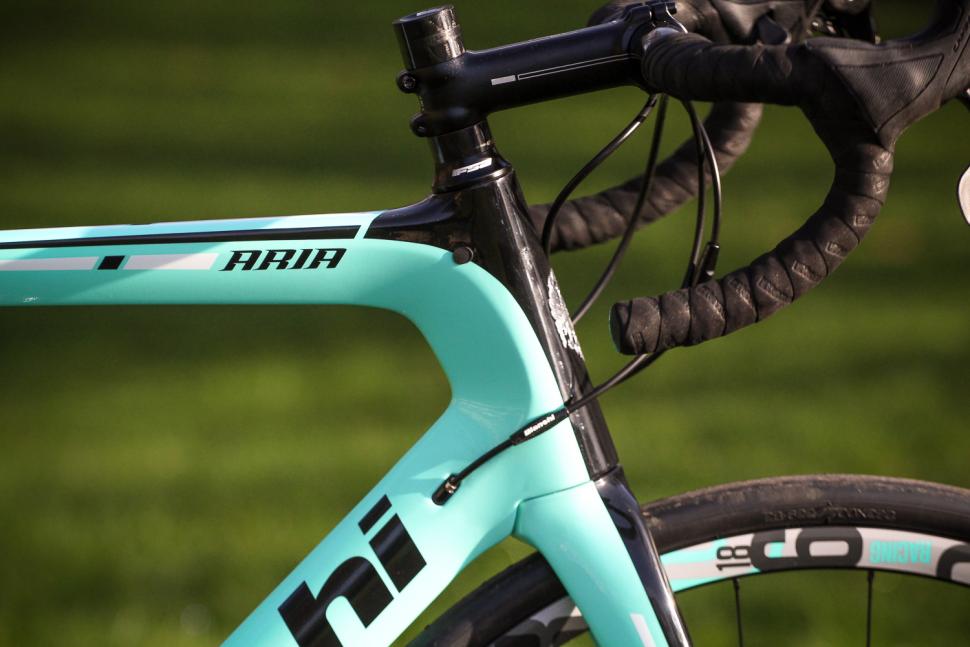
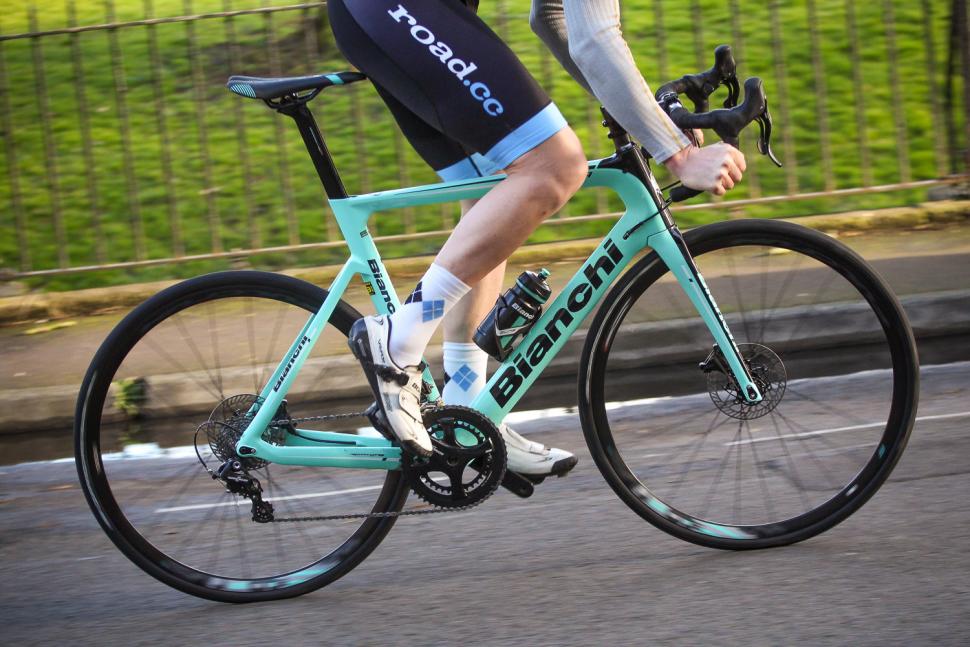
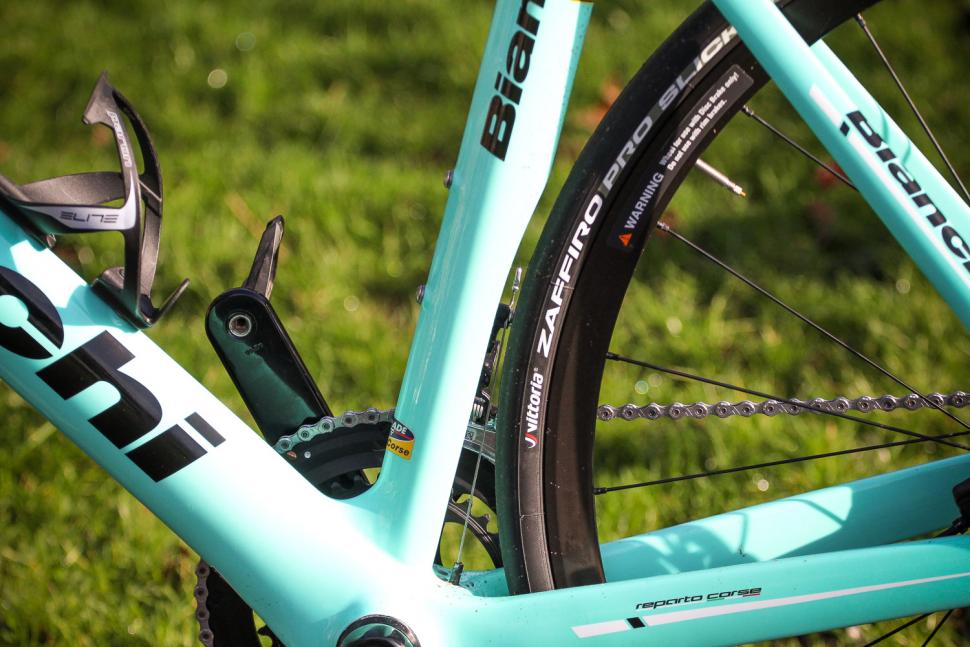
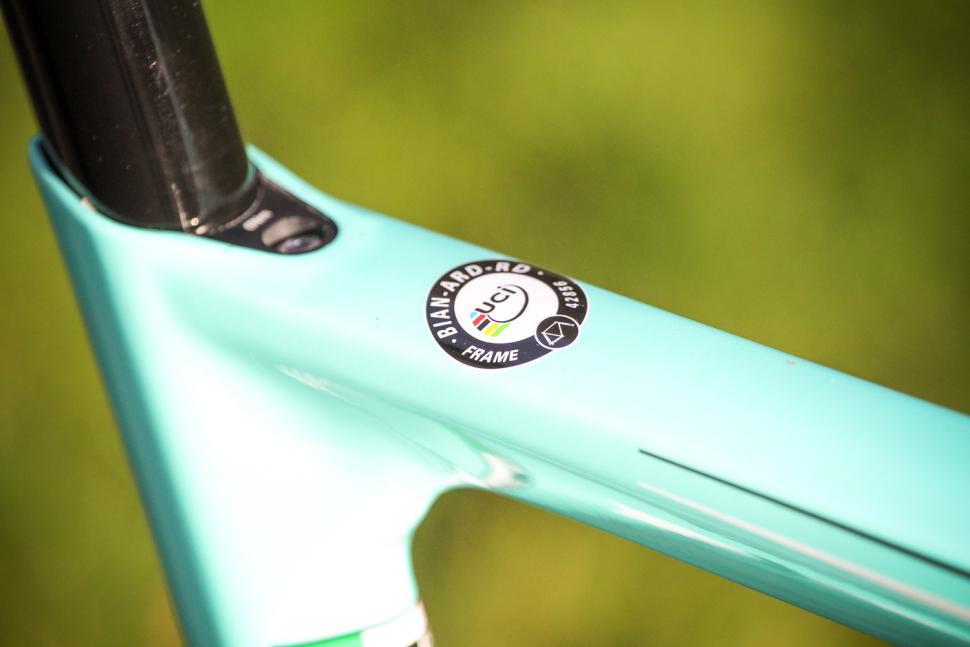

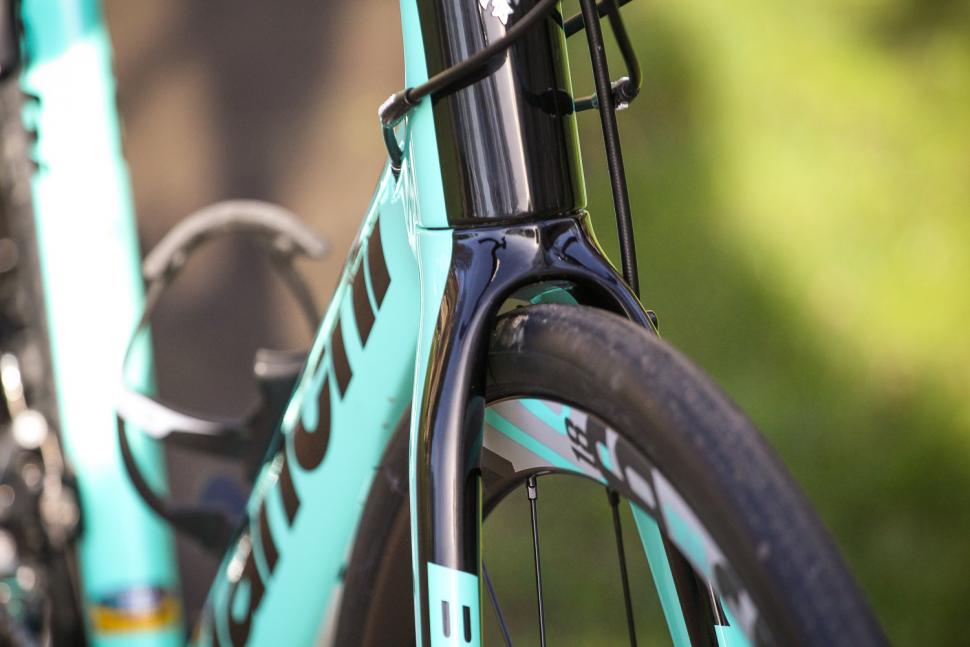







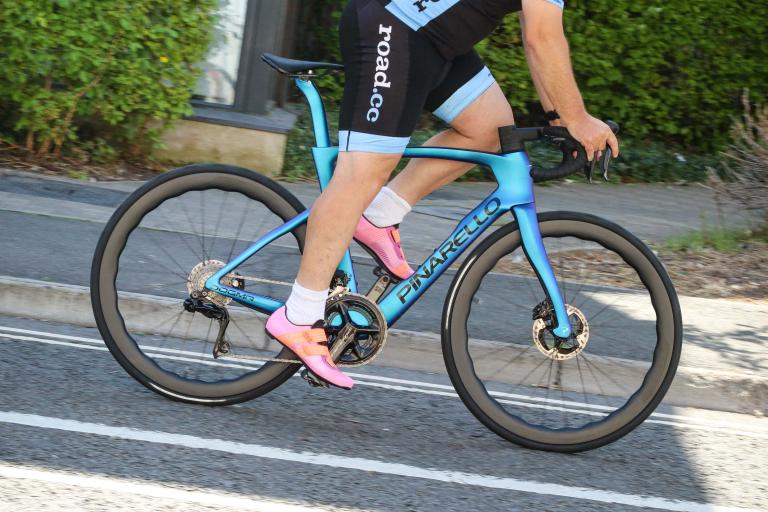
Add new comment
16 comments
Which size would you recommend for my length 180 cm? My current bike is caad10 56 cm
I don't know how I've managed this far with rim brakes in bad weather, if only i'd known they didn't have all weather stopping power.
As an owner of a 3K disc brake bike, I never want to take it out in the rain and usually opt for the #2 with mud guards.
I would also like to add that hydraulic discs are far from problem free as well
Zaffiro tyres shod on a bike that costs this much.....that’s just a slap in the face to the consumer, and a kick in the back as well. No bike deserves tyres that shoddy.
A nice Bianchi. But I’d spend a little more and get a proper Oltre.
Not fussed by disk brakes, but I’ll be honest out of all the systems the Campagnolo ones actually look nice.
Beauty is in the eye of the beholder, of course, but they look a bit agricultural to me compared to SRAM Red, for example.
SRAM-Red-eTap-HRD-1.jpg
I have the Potenza disc groupset but I'm inclined to agree with you here...I don't mind the steampunky look of the calipers, but they're not what you'd normally expect Campagnolo gear to look like. Sram and Campy should swap caliper designs, both go better with the other groupset .
The Campag caliper looks a bit steampunk as the other chap said, but the SRAM one just looks overstyled to me. With the exception of C-Record, Campag components were always the shape that worked, rather than styled.
In the headline: "now with the all-weather stopping abilities of hydraulic disc brakes". So it's always been impossible to stop a bike in the rain or snow with rim brakes? When is this myth going to be dispelled.
I have both rim brakes, hydraulic and mechanical disc brakes. They all brake perfectly. I even prefer rim brakes, and uuhh gues what, it's very easy to block the wheel with rim brakes also so braking performance is certainly not less. I know, in the rain you lose a couple of yards with rim brakes. So what do you do? Brake lightly two yards earlier so the water gets off the rim. The main advantage of disc brakes is their detachment from the wheel itself. Less rim wear, easier to take off wheel and generally you can fit wider tyres. But, price and maintanence so much easier/cheaper with rim brakes. The pros seem quite happy with rim brakes also.
Nope, your second sentence doesn't follow from the first. A disc brake's ability to stop you quickly and safely is less compromised by wet weather than that of a rim brake. Clearly, they'll both stop you. Dapping your foot on the ground will stop you too, but that doesn't mean your shoes have the same level of all-weather stopping capabilities as disc brakes. Not to my mind, anyway. Maybe you feel differently.
Exactly.
Wheels, solid but unspectacular? I'd say the money is in the frame and Potenza components.
Any comment on the wheels?
This is Potenza with a UT chainset and the new disc brakes so as Potenza goes, it's quite posh. I might biased on this point as a boxful of Potenza disc components arrived on my doorstep this very morning.
For £3500, i'd want a Record groupset or at the very least Chorus. Potenza isn't cutting it at that price i'm afraid
Record groupset for £3500!! Not these days I'm afraid. You won't find any premium bikes with record and you'd be hard pushed to get chorus for that price.
Nice review - thanks.